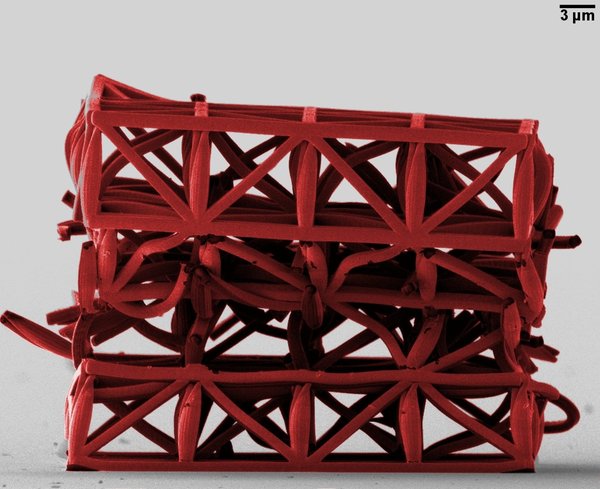Future Spacecrafts Built With Lightweight, Strong Material That Mimics Bone Structure Possible
Engineers from the Karlsruhe Institute of Technology, Germany have been able to create a lightweight yet strong material that replicates the intricate architecture of the human bones using 3D laser lithography technique. Its applications can be found in the material used for the construction of future spacecrafts owing to the super light weight property and high tensile strength. The material created by the German researchers is said to have the highest strength-to-weight ratio of any engineered cellular structure yet. Their research work speaks volumes about how changes at the micro and nano scale in the architecture of key structural elements can significantly improve the material's performance.
The researchers behind this biologically inspired material are Jens Bauera, Stefan Hengsbachb, Iwiza Tesaria, Ruth Schwaigera, and Oliver Krafta and their work has been published in a paper at the #-Link-Snipped-# journal. The lead author - Mr. Jens Bauer, a mechanical engineer at the Karlsruhe Institute of Technology says, "Now we have to figure out how we can go further - and one idea is to do it like nature does." Existing industrial materials are dense and heavy and material engineers are working on removing these drawbacks.

The KIT researchers have made use of a system supplied by Nanoscribe – a spin-out company from the institute – to create a series of complex engineering architectures in a sample of polymer. The 3D direct laser writing technique was used to focus laser on the sample of photo-curable polymer that is mounted on a computer-controlled stage that can move in 3D. With this, they have been able to create different designs such as cubic grids with diagonal supports and hexagonal honeycomb-like structures. It is not easy to develop strong materials that have density lesser than water, but human bones and wood don't suffer from this issue. The living are porous (thus lightweight) but still very strong.
The technology is still at a nascent stage and mass production still looks far-fetched, but it does take a significant leap towards developing more and more bio-inspired materials. Take a look at this video -
What do you think about taking inspiration from living things and nature for building the strong materials of the future? Share your thoughts with us in comments below.
The researchers behind this biologically inspired material are Jens Bauera, Stefan Hengsbachb, Iwiza Tesaria, Ruth Schwaigera, and Oliver Krafta and their work has been published in a paper at the #-Link-Snipped-# journal. The lead author - Mr. Jens Bauer, a mechanical engineer at the Karlsruhe Institute of Technology says, "Now we have to figure out how we can go further - and one idea is to do it like nature does." Existing industrial materials are dense and heavy and material engineers are working on removing these drawbacks.

The KIT researchers have made use of a system supplied by Nanoscribe – a spin-out company from the institute – to create a series of complex engineering architectures in a sample of polymer. The 3D direct laser writing technique was used to focus laser on the sample of photo-curable polymer that is mounted on a computer-controlled stage that can move in 3D. With this, they have been able to create different designs such as cubic grids with diagonal supports and hexagonal honeycomb-like structures. It is not easy to develop strong materials that have density lesser than water, but human bones and wood don't suffer from this issue. The living are porous (thus lightweight) but still very strong.
The technology is still at a nascent stage and mass production still looks far-fetched, but it does take a significant leap towards developing more and more bio-inspired materials. Take a look at this video -
0
